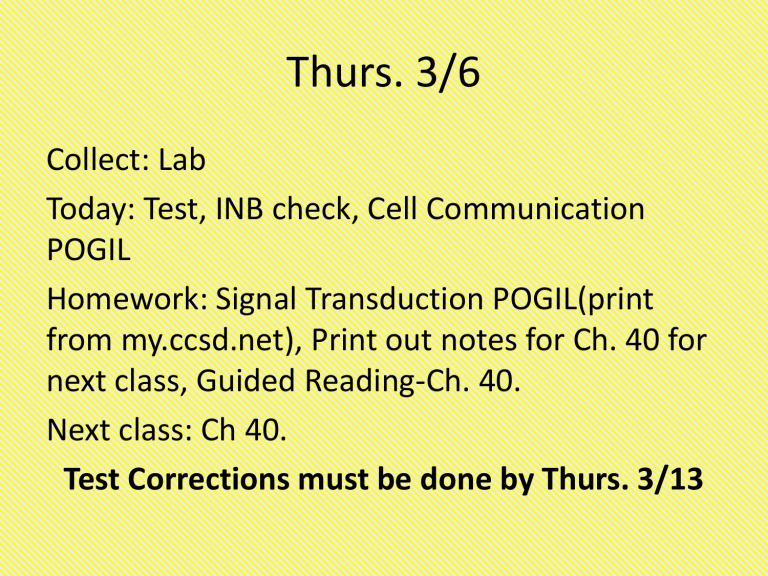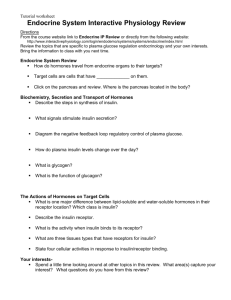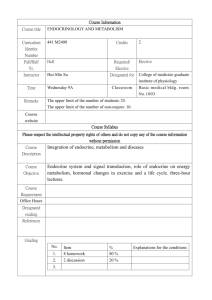Chp.45: Hormones & the Endocrine System (review: Chp.11 Cell

Thurs. 3/6
Collect: Lab
Today: Test, INB check, Cell Communication
POGIL
Homework: Signal Transduction POGIL(print from my.ccsd.net), Print out notes for Ch. 40 for next class, Guided Reading-Ch. 40.
Next class: Ch 40.
Test Corrections must be done by Thurs. 3/13
Pg. 144
Ch 40 Guided Reading
Pg. 145
Ch 40 EK Paragraph
3D2 or 3D3
In: pg. 146
Watch video clip: Bozeman Cell Communication.
• Complete Video Guide and tape in.
Cell Communication POGIL
• Complete ONE copy in groups of 3-4 and turn in at end of period.
Pg. 147
Signal Transduction POGIL
Print out the Signal Transduction POGIL from my.ccsd.net, complete and turn in next class. It will go on this page when returned.
Out
Why is cellular communication is important for:
• Unicellular organisms?
• Multicellular organisms?
Mon. 3/10
Collect: Signal Transduction POGIL and Guided
Reading-Ch 40
Today: Finish Cell Comm. POGIL, Notes-Ch 40
Homework: Endocrine diagrams and Guided
Reading-Ch 37. Print Ch. 37 powerpoint for next class.
Next class-Quiz-Ch 40
Test corrections by Thursday!!!
In: pg 148
What is the difference between and endocrine gland and exocrine gland? Give an example of each.
Pg. 149
Chp.40: Hormones & the
Endocrine System
Remember:
• Why cells need to communicate:
– Coordinate activities in multicellular organisms
– Hormone actions
– Cell recognition
– To find mates (yeast cells)
– Turn pathways on/off
– apoptosis
10
Evolutionary ties of cell communication
• Cell-to-cell communication is everywhere in biological systems from Archaea and bacteria to multicellular organisms.
• The basic chemical processes of communication are shared across evolutionary lines of descent.
• Signal transduction is an excellent example
11
Signal Transduction Animation
• Click on this link to access the animation: http://www.wiley.com/college/boyer/0470
003790/animations/signal_transduction/sig nal_transduction.htm
12
Chemical Communication
Outside the body
Inside the body
Ex.
Pheromones
Ex. Quorum sensing
Short
Distance
Long
Distance
13
Pheromones
• Members of the same animal species sometimes communicate with pheromones, chemicals that are released into the environment.
• Pheromones serve many functions, including marking trails leading to food, defining territories, warning of predators, and attracting potential mates.
14
Quorum sensing
• Quorum sensing in bacteria – single celled bacteria monitor their environment by producing, releasing and detecting hormonelike molecules called autoinducers.
15
Chemical Communication
Inside the body
Short
Distance
Long
Distance
Paracrine Autocrine Hormones
Example
Prostaglandin
Example
Interleukin
Example
Insulin
16
Direct Contact Communication
Ex
.
Plant cells communicate directly through openings called plasmodesmata.
17
Short Distance Communication
• Paracrine signals diffuse to and affect nearby cells
– Ex. Neurotransmitters
– Ex. Prostaglandins
18
Neuron
Synaptic signaling
Neurosecretory cell
Blood vessel
Neuroendocrine signaling
Response
Synapse
Response
Autocrine signals
• These chemicals affect the same cells that release them.
– Ex. Interleukin-1 produced by monocytes and can bind to receptors on the same monocyte.
– Tumor cells reproduce uncontrollably because they self-stimulate cell division by making their own division signals.
20
Long Distance Communication
• Endocrine hormones via signal transduction pathway:
21
Hormones
• Endocrine glands produce hormones which are
– Chemical signals
– Transported in tissue fluids
– Detected only by target cells
22
Summary:
23
Communication Features
• Secreting cell - releases the signal
• Signal = chemical = ligand
• Receptor - accepts and temporarily joins with the ligand forming receptor/ligand complex
• Target cell – contains the receptor
24
Apply the features
• Insulin is secreted by beta cells of the pancreas. Once secreted, insulin travels around the body. When insulin docks with an integral protein on the membrane of a muscle cell, glucose can enter the cell.
• What is the secreting cell, the target cell, ligand, and the receptor?
25
Endocrine System
• The human endocrine system is composed of a collection of glands that secrete a variety of hormones.
• These chemicals use long distance communication to control the daily functioning of the cells of the body, maintain homeostasis, respond to environmental stimuli, and growth & development.
26
Endocrine System
• The endocrine system produces more than
30 different chemicals used by your body to and promote normal body function.
• This system contains 9 primary glands as well as endocrine cells found within major organs.
• The endocrine system is a ductless system that employs the circulatory system when delivering chemical signals over long distances.
27
28
The Endocrine System works with the Nervous System
• Two systems coordinate communication throughout the body: the endocrine system and the nervous system.
• The endocrine system secretes hormones that communicate regulatory info throughout body.
• The nervous system uses neurons to transmit signals; these signals can regulate the release of hormones.
Table 45.1a
Table 45.1b
Figure 45.17
Pathway Stimulus
Hypothalamus
Sensory neuron
Neurosecretory cell
Releasing hormone
Blood vessel
Anterior pituitary
Tropic hormone
Endocrine cell
Hormone
Target cells
Response
Cold
Example
Hypothalamus secretes thyrotropin-releasing hormone (TRH).
Anterior pituitary secretes thyroid-stimulating hormone (TSH, also known as thyrotropin).
Thyroid gland secretes thyroid hormone
(T
3 and T
4
).
Body tissues
Increased cellular metabolism
The Process of Communication:
Signal-Transduction Pathway
Three stages of the Signal-
Transduction Pathway
1. reception
2. transduction
3. response
Typical Signal Transduction Pathway
Ligand = Chemical Messenger
• Three major classes of molecules function as hormones in vertebrates (ligands)
– Polypeptides (proteins and peptides)
– Amines derived from amino acids
– Steroid hormones
35
Cellular Response Pathways
• Water- and lipid-soluble hormones differ in their paths through a body
• Water-soluble hormones are secreted by exocytosis, travel freely in the bloodstream, and bind to cell-surface receptors
• Lipid-soluble hormones diffuse across cell membranes, travel in the bloodstream bound to transport proteins, and diffuse through the membrane of target cells
Type of Receptor: Ex- G-protein linked
( Water soluble = polypeptides & amines, can’t pass cell membrane)
Type of Receptor:
Intracellular Receptor
(Lipid Soluble = Steroid
Hormones, can pass cell membrane)
SECRETORY
CELL
Watersoluble hormone
Lipidsoluble hormone
VIA
BLOOD
Signal receptor
Transport protein
TARGET
CELL
OR
Signal receptor
Cytoplasmic response
(a)
Gene regulation
Cytoplasmic response
NUCLEUS
(b)
Gene regulation
Recap
EXTRACELLULAR
FLUID
1 Reception
Receptor
Plasma membrane
2 Transduction
CYTOPLASM
3 Response
Activation of cellular response
Relay molecules in a signal transduction pathway
Signaling molecule
Multiple Effects of Hormones
• The same hormone may have different effects on target cells that have
– Different receptors for the hormone
– Different signal transduction pathways
Multiple Effects of Hormones
• The hormone epinephrine has multiple effects in mediating the body’s response to short-term stress
• Epinephrine binds to receptors on the plasma membrane of liver cells
• This triggers the release of messenger molecules that activate enzymes and result in the release of glucose into the bloodstream
43
Same receptors but different intracellular proteins (not shown)
Different receptors
Different cellular responses
Different cellular responses
Epinephrine
receptor
Glycogen deposits
Epinephrine
receptor
(a) Liver cell
Glycogen breaks down and glucose is released from cell.
Vessel dilates.
(b) Skeletal muscle blood vessel
(c)
Epinephrine
receptor
Vessel constricts.
Intestinal blood vessel
Insulin and Glucagon:
Control of Blood Glucose
• Hormones work in pairs to maintain homeostasis.
• Insulin (decreases blood glucose) and glucagon
(increases blood glucose) are antagonistic hormones that help maintain glucose homeostasis.
• The pancreas has clusters of endocrine cells called pancreatic islets with alpha cells that produce glucagon and beta cells that produce insulin.
Figure 45.13
Body cells take up more glucose.
Blood glucose
Liver breaks level rises.
down glycogen and releases glucose into the blood.
Blood glucose level declines.
Liver takes up glucose and stores it as glycogen.
Homeostasis:
Blood glucose level
(70–110 mg/100mL)
Insulin
Beta cells of pancreas release insulin into the blood.
STIMULUS:
Blood glucose level rises
(for instance, after eating a carbohydrate-rich meal).
STIMULUS:
Blood glucose level falls (for instance, after skipping a meal).
Alpha cells of pancreas release glucagon into the blood.
Glucagon
Out of Balance: Diabetes Mellitus
• Diabetes mellitus is perhaps the best-known endocrine disorder.
• It is caused by a deficiency of insulin or a decreased response to insulin in target tissues.
• It is marked by elevated blood glucose levels.
Out of Balance: Diabetes Mellitus
• Type 1 diabetes mellitus (insulin-dependent) is an autoimmune disorder in which the immune system destroys pancreatic beta cells.
• Type 2 diabetes mellitus (non-insulindependent) involves insulin deficiency or reduced response of target cells due to change in insulin receptors.
Insulin & Glucose Regulation
Pg. 150
Diagram and label fig.
40.12 AND 40.15.
Pg. 151
Create a similar diagram for the stress response.
One loop will be short term stress and the other loop will be long term stress.
Out
• Insulin and glucagon are antagonistic hormones. What does this mean? Use a specific example.









